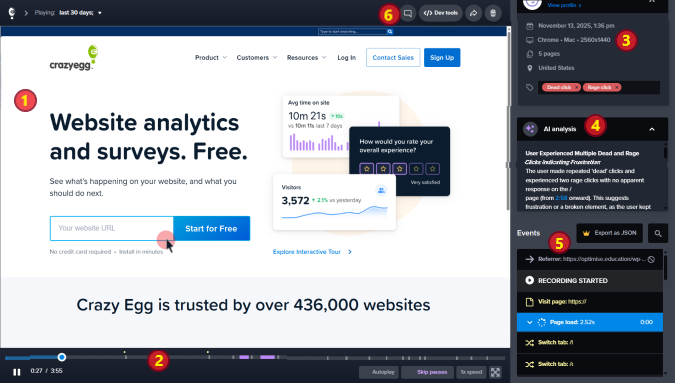Product demonstrations follow the golden rule of “Show, don’t tell.” It’s a high-impact sales resource to close more deals/signups that also serves as a factor in a buyer’s purchase decision process.
I’ve explored almost every single product demo aspect for making product demonstrations work in your favor so you don’t have to. From foundational concepts and different product demo types all the way down to examples of product demo and best practices.
What is a product demo again?
In a nutshell, a product demo is a strategic sales presentation that illustrates the core functionality, features, and value proposition of a product/service to prospects so it supports the buying decision.
Unlike sales enablement content, demos bridge the gap between initial customer awareness and final purchase commitment. Which often happens during the consideration stage of the sales funnel.
Here’s why product demos still matter
Besides the mere feature showcasing, product demos can:
- Visually present how products should work in action
- If interactive, prospects can engage with the product
- Make two-way communication easier through dialogue
- Speed up potential customers through the sales journey
- Bring a narrative that tie capabilities to specific pain points
- Handle common objections from your ideal customer profile
As you may have guessed, it’s different from other sales collateral. Because demos let folks envision the thing to validate suitability.
The true demo’s impact comes from a higher buying intent after either the person interacting with the demonstration or booking a live demo with an SDR (sales development representative).
Types of product demos that never get old
I can think of these 3 product demonstration types at the moment:
1. Live demos. This is a real-time, human-led resource where a product specialist or salesperson walks a prospect through the product. It’s a format ideal for Q&A and customization on the fly.
2. Video demos. On-demand videos showing the product in action. E.g. a tutorial, a screen-capture overview, or a teaser. Videos demand less effort than live demos. But they’re not interactive.
3. Interactive demos. Self-service demos that let prospects play around with controlled, simulated product screens (or use cases) 24/7 to click buttons, enter sample data, and select features.
- Product tours: Similarly to core interactive demos, guided product tours highlight a workflow (with pop-ups or callouts). These can be led by a clickable guided path or a sales rep.
- Sandbox trials: Also known as “simulations,” it’s an interactive trial environment where prospects access a limited version of the product themselves with dummy data.
You can adapt each type of product demo to different contexts.
Like web-based demos, email-embedded demos, mobile demos, and social media demos. Depth and length may vary, though.
Overviews (~1-3 minutes) for feature highlights. Standard demos (~5-15 minutes) for thorough walkthroughs. Deep dives (~15-45+ minutes) for technical implementation details. It really depends on audience sophistication, product complexity, and sales cycle stage.
Step-by-step product demo methodology
With product demo software (Navaticc, Storylane, Consensus—to name a few), you can implement interactive demos in no time.
But the thing is, regardless of the product demo type, there’s a set of systematic procedures most effective demonstrations have in common to maximize engagement and conversion potential.
Step #1: Pre-demo preparation
Good demos start with research. Know your audience whether you’re making a pre-recorded, interactive, or one-on-one live demo.
Research your audience thoroughly. Check the company site, recent social media updates, and industry news to picture the challenges and market pressures. Look for announcements, leadership changes, or initiatives that might shift priorities.
Map the stakeholders. Find out who’s the final decision-maker and champions. For each person, note the jobs-to-be-done, likely concerns, and definition of success. E.g., CTOs may worry about implementation complexity, CFOs focus on ROI and budget impact.
Analyze customer pain points. Revisit previous conversations and identify patterns from similar customers in the industry. What processes are breaking down? Where are they losing time or money? Document examples to reference during your demo.
Prepare your demo environment. With sample data that mirrors the prospect’s use case. Let’s say you’re hypothetically demoing CRM software to a manufacturing company, you want to consider using manufacturing jargon and realistic scenarios they’ll relate to.
Define success metrics. Create a structured flow that addresses key concerns. Decide how much customization to include and prepare responses for likely objections. This prep work transforms any demo from a generic walkthrough into a targeted sales deck.
Step #2: Demo structure and flow
This framework adapts principles from The Ultra-Effective Sales Demo Framework and works well across all product demo formats.
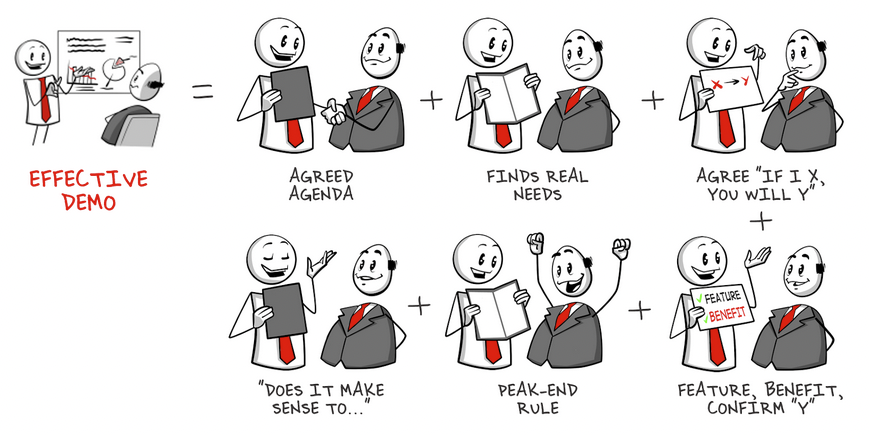
Agree on the agenda. Set clear expectations about what you’ll cover and timing. For live demos, confirm priorities. For recorded videos, state the agenda upfront so viewers know what to expect.
Find real needs. In live settings, ask questions about challenges and desired outcomes. For video and interactive demos, address common pain points and jobs-to-be-done from your research. Reference industry challenges to show context understanding.
Create commitment. For live product demonstrations, get explicit agreement: “If I show you how this solves your XYZ bottleneck, does it make sense to discuss XYZ?” For other formats, frame the value proposition and explain what viewers should evaluate.
Apply the peak-end rule. People remember emotional peaks and endings, so place your strongest demonstrations strategically. Save the most impressive product feature for the climax, not the opening.
Feature-benefit-confirm approach. Present each capability by showing the feature, explaining the benefit to the buyer’s situation, and confirming relevance. Start with the highest-priority needs. And demonstrate how your product handles competitors’ use cases.
Close with clear next steps. Wrap up insights and specify what happens next. Whether that’s booking a follow-up, a trial, or having discussions, make the path forward explicit and easy to execute.
Step #3: Handling Q&A and objections
Treat objections as engagement opportunities. When someone raises a concern, they’re revealing what matters most to them.
Prepare evidence-based responses. Anticipate objections and collect a few case studies of how other customers overcame similar issues. Scrambling for answers during a demo might kill credibility.
Handle different demo types tactically. For live demos, welcome questions throughout and use strategic pausing to gauge understanding. With pre-recorded and interactive demos, tackle pain points proactively and tell viewers when to expect what.
Acknowledge and redirect objections. When an objection arises, acknowledge it. Then redirect with examples: “That’s a common concern. Let me show you how [XYZ company] handled that.” This validates the prospect’s thinking while moving toward a solution.
Conversational energy trumps all. Illustrate complete workflows instead of isolated features only. Because this helps stakeholders see the full value proposition and reduces feature objections.
Follow up systematically. Within 24H, send a thank-you message with a demo summary. Share resources that answer remaining doubts and specify next steps. If additional stakeholders need to see the demo, offer customized versions or separate sessions.
Measure signs of genuine interest. Such as time extensions beyond planned duration, requests to involve other people, and next-step commitments. Monitor demo-to-qualified-opportunity conversions and how demos impact overall sales cycle length.
Real-world product demo examples
The following examples aim to make abstract product claims concrete. Effective demos focus on a clear story. Like “Here’s the problem your customers have. Here’s how our product solves it.”
Geoffrey James, a contributing editor for Inc., puts it best “There is almost nothing more powerful than a great product demonstration. When done correctly, a demo allows the customer to see and feel how things will be better if they buy (and worse if they don’t).”
Here’s a few illustrative examples of product demonstrations:
Slack’s interactive product demo
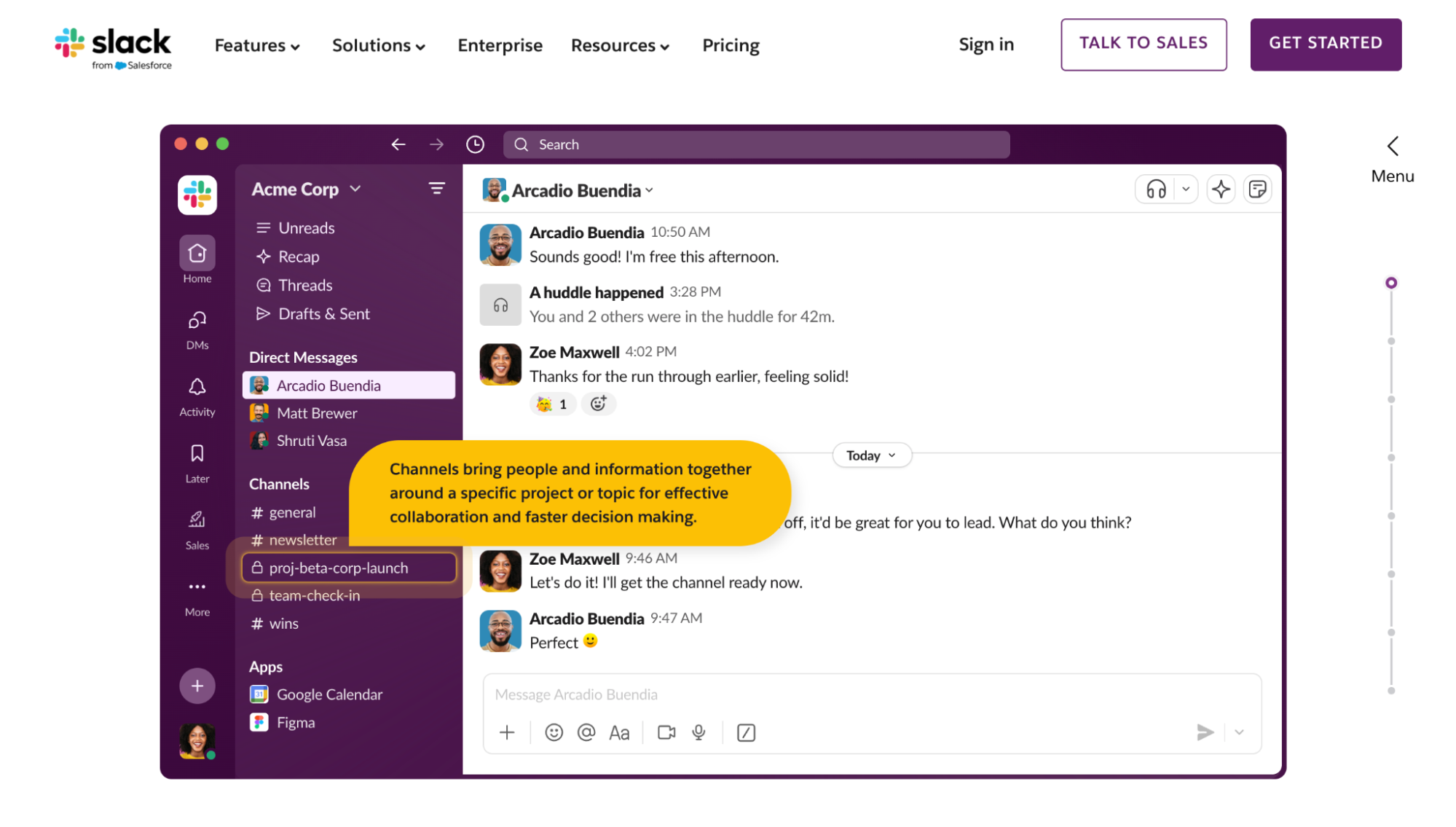
Instead of pitching features, this demonstration follows a simple “Claim > Show > Explain” approach, positioning Slack as the place “how work happens” for newcomers, existing customers missing features, and business leaders wanting better communication.
The demo in question covers 5 strategic areas, from team collaboration to cross-company connections, targeting decision-makers. It showcases 3 core benefits: tool integration, centralized knowledge management, and boosted productivity.
The tour walks through key features using smooth animations and minimal text. Just enough interaction to communicate value without overwhelming visitors. It’s accessible at slackdemo.com without filling out forms, letting the product itself drive customer acquisition.
GoPro’s pre-recorded video demo
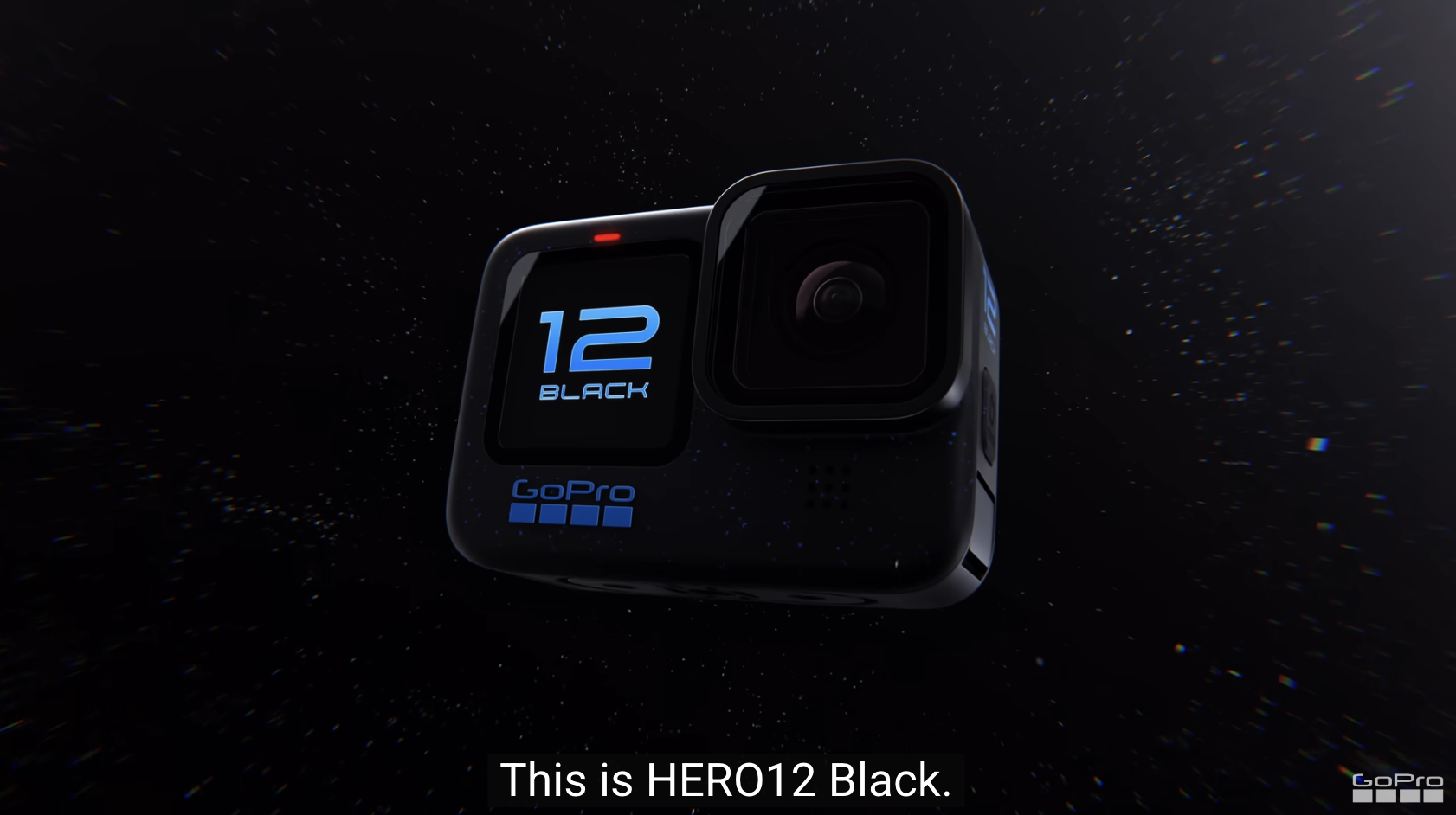
GoPro skips traditional product demonstrations. This 10-minute HERO12 Black demo shows the camera performing in scenarios where action cameras face conditions that push physical limits.
What makes this product demo work? GoPro’s cameras have gotten so good that user footage rivals lots of professional shoots.
So instead of sterile studio demonstrations, the brand features authentic action sequences that prove durability and performance claims through slow-motion footage in challenging environments.
Less technical specs, more letting viewers experience the world through explorers’ eyes. It’s aspirational content that doubles as a product demonstration, showing what someone could capture.
Klue’s role-based product demo arena
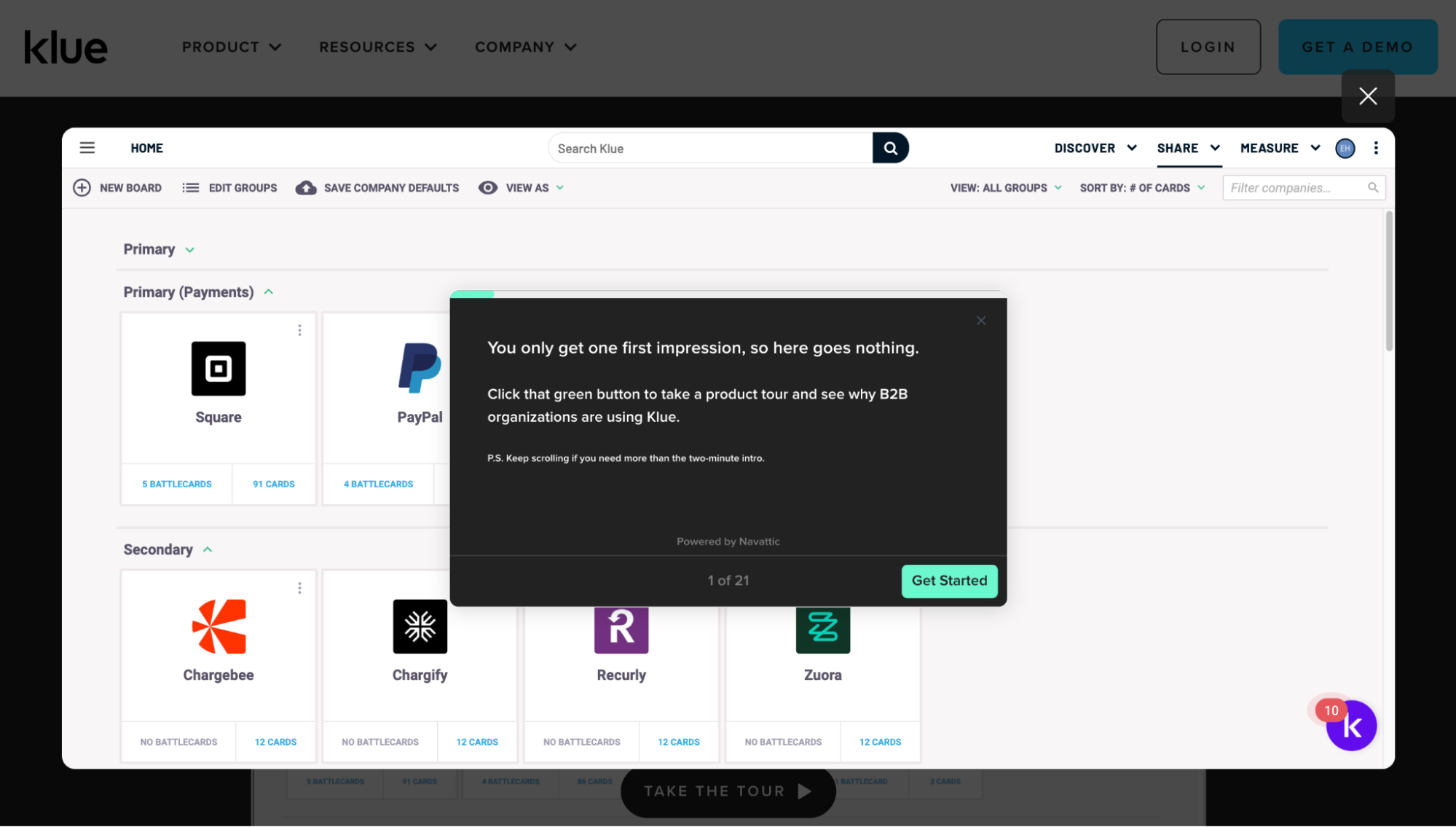
“Test drive Klue on your own time” is Klue’s demo arena invitation.
Competitive intelligence (CI) needs vary significantly based on organizational roles and responsibilities. And Klue found a way to create separated paths for competitive intelligence professionals, sales leaders, marketing leaders, and sales enablement teams.
Each tour addresses multiple customer pain points. Prospects can explore functionalities tailored to their specific role and challenges.
From helping CI pros analyze competition and show the C-suite why they need investment to getting the sales team up to speed generate revenue faster. The self-service approach eliminates friction. No scheduling sales meetings or waiting for demos.





